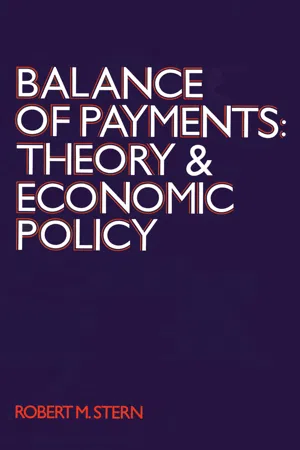Economics
Expansionary and Contractionary Fiscal Policy
Expansionary fiscal policy involves increasing government spending and/or reducing taxes to stimulate economic growth and boost aggregate demand. On the other hand, contractionary fiscal policy involves decreasing government spending and/or increasing taxes to slow down an overheated economy and reduce inflationary pressures. These policies are used by governments to manage the overall level of economic activity.
Written by Perlego with AI-assistance
Related key terms
8 Key excerpts on "Expansionary and Contractionary Fiscal Policy"
- eBook - ePub
- Arleen J Hoag, John H Hoag(Authors)
- 2006(Publication Date)
- WSPC(Publisher)
Time lags are another political problem with fiscal policy. First it may take some time before the president and the Congress realize that some policy action is needed, perhaps an increase in government spending. Then it takes time to formulate the policy, as the Congress will have to hold hearings and develop legislation. Both houses of Congress have to pass the legislation and add the funding to the next budget. And when the money is spent, it will take time for the multiplier to work and the policy to be felt in the economy. So there can be substantial lags between when the policy is needed and the time the policy is felt in the economy. By that time, there may have been a change in consumption or investment so that the opposite fiscal policy is required. Constant adjustments in fiscal policy might be needed to achieve full employment. You can see that achieving full employment is not an easy task. Do not expect economics to be an exact science. We should be suspicious of those who tell us that full employment can be easily achieved and maintained.Perspectives on Fiscal PolicyThe choice of fiscal tools influences the degree of government involvement in the economy. If government spending for goods is increased to enact an expansionary policy, then the government has more control over resource use. More resources would flow into the production of public goods. If instead taxes were reduced on business, individuals, or both, then there would be more private spending and more resources would flow into the private sector. More resources would be allocated into television sets rather than roads, into cars rather than tanks. During a contractionary policy, a reduction in government spending, rather than an increase in taxes, would lessen government influence and permit more private decision making. Conservatives may favor less government spending and lower taxes because they feel that every time the government acts, the role of the government in the economy grows but never gets smaller. For those who favor a smaller share of the economy controlled by the government and a larger share controlled by private firms and individuals, this constant growth by the government is a threat. - eBook - ePub
- Rob Dransfield(Author)
- 2013(Publication Date)
- Routledge(Publisher)
Fiscal policy is the deliberate manipulation of government expenditure and revenues in order to achieve given policy objectives. At one level this involves the relationship between total public spending and total public revenues. For example, a deficit budget can pump extra spending into the economy whereas a budget surplus would withdraw spending from the economy. Fiscal policy also involves adjusting different types of tax and spending in order to target specific objectives. For example, the government may shift the emphasis from direct to indirect taxes or from regressive to progressive taxes.Keynesian economists believe that fiscal policies can be used by the government to stimulate the economy. In contrast neoclassical and monetarist economists believe that there should be a balanced budget.Key Ideas Fiscal policy- Fiscal policy is government policy designed to use its own spending and the taxes that it raises in order to achieve desired policy objectives such as full employment or economic growth.
- Whereas monetarists seek to balance government revenues and taxes, Keynesian economists believe that fiscal stimulus can be used to support economic growth and to counteract unemployment.
- The balance between government spending and taxes is made up by government borrowing (or paying back debt).
- The main area of government expenditure is on welfare, including health, education and social benefits.
- Government expenditure is one of the main ingredients of GDP.
- Free market supporters believe in rolling back the size of the government in the economy.
- Government spending includes central and local government spending.
- Progressive taxes take a greater percentage of income from the rich than the poor. Regressive taxes take the greatest proportion from the poor.
- Direct taxes are deducted directly from a taxpayer’s income at source. In contrast, indirect taxes are collected by a third party on behalf of the government and citizens have a choice as to whether to buy goods with indirect taxes imposed on them.
- eBook - ePub
Macroeconomic Analysis and Policy
A Systematic Approach
- Joshua E Greene(Author)
- 2017(Publication Date)
- WSPC(Publisher)
In times of large deficits, rising public debt, and lack of confidence, the fiscal multiplier can be small or even negative, by creating expectations of future tax increases. If the macroeconomic situation is sufficiently precarious, expansionary fiscal policy can lead to a sharp fall in activity by creating expectations of a fiscal or macroeconomic crisis. In these circumstances, fiscal stimulus can prove counterproductive. Developing countries offer many examples of this situation, a recent one being the adverse consequences of expanding the deficit by raising energy subsidies in Pakistan during 2008.When fiscal policy is unsustainable, fiscal contraction may prove expansionary. The main examples of so-called “expansionary contraction” in advanced economies involved countries with high debt/GDP ratios and relatively high tax burdens, such as Denmark and Ireland in the 1980s. In these countries, cuts in spending that reduced budget deficits, accompanied by exchange rate depreciation, helped boost economic activity. Indeed, Ireland’s reforms unleashed a wave of economic growth that dramatically raised per capita incomes from the late 1980s until 2008, when a banking crisis engulfed the economy. In developing and emerging market countries, fiscal contraction has often been the key to reducing current account deficits and restoring a viable balance of payments. Thus, macroeconomic stability has a critical bearing on the effectiveness of fiscal policy in stimulating economic activity.C. Pro-Cyclical vs. Counter-Cyclical Fiscal Policy
The impact of fiscal policy on aggregate demand means that fiscal policy can play an important role in stabilizing macroeconomic activity by expanding policy (cutting taxes and raising expenditures) when the economy is in recession or below potential output and tightening policy (raising revenues and reducing expenditures) when economic activity exceeds potential output and inflation begins to accelerate. In most economies, revenues follow a natural counter-cyclical pattern, rising more than proportionately when the economy expands and falling significantly when it contracts, because of progressive income and profits taxes and the tendency for corporate profits to rise (and fall) even faster than changes in economic activity. In many advanced economies, programs such as unemployment insurance, disability pensions, and special benefits for the poor make expenditures follow a similar pattern, as outlays for these programs expand during slowdowns and contract as the economy recovers. Thus, fiscal policy tends to be counter-cyclical in these economies, unless overwhelmed by legislated tax cuts and spending increases when economic activity is buoyant. - eBook - ePub
- James J. Gosling, Marc Allen Eisner(Authors)
- 2015(Publication Date)
- Routledge(Publisher)
Economic growth carries a number of benefits: increased personal income, resources for investment, new job opportunities, and enhanced citizen support for government and incumbents. Yet economic prosperity cannot be taken for granted. Workers, businesses, and elected public officials reap the benefits of growth and suffer the consequences of decline. In one sense, they are captive of the vagaries of economic cycles and fluctuations. In another sense, however, all share the conviction that government can and should act to stabilize the economy at desired levels of economic performance. Policymakers rely primarily on fiscal and monetary policy to manage the economy. This chapter addresses fiscal policy.Fiscal policy deals with the tax and spending decisions of national governments. In the United States, that means the tax and spending decisions of Congress, as affected by actions of the president. Tax and spending choices influence the national economy by affecting aggregate demand. Government taxes reduce aggregate demand because they take resources away from individuals and businesses that might otherwise be spent. Conversely, tax cuts transfer resources from the public to the private sector and increase after-tax disposable income that can be spent. Tax policy, depending on its structure, can also affect aggregate supply, to the extent that it provides strong incentives for individuals or firms to save and invest rather than spend.Government spending adds to aggregate demand through the purchases that government makes directly or through those made by the recipients of government financial assistance, whether they be individuals or other governmental units. In the latter case, states and local governments in the United States spend federal aid directly or distribute it to individuals who, in turn, spend it. In either case, this added spending increases aggregate demand. Government spending can also influence the level and potential growth of a nation’s economy, depending on the nature of that spending. Government spending on physical infrastructure, such as highways and bridges, and on education, technology development, and basic research can provide the basis for increased productivity and the higher personal income that follows. - eBook - ePub
- Hal W. Snarr(Author)
- 2014(Publication Date)
- Business Expert Press(Publisher)
This makes U.S. products more expensive abroad, which reduces U.S. exports (X). The arrows in the following equation model the consequences of increased government borrowing. Although increasing the size of the budget deficit (higher G and lower T) shifts AD from point A to B as shown in Figure 5.6a, crowding out (higher r and lower X, H, and F) shifts AD back to point A. Hence, the intended consequence of fiscal policy is accompanied by unintended domestic consequences, higher interest rates and lower investment expenditure, and an unintended international consequence, a reduction in exports caused by an appreciating dollar. Although Keynesian economics advocates for countercyclical changes in the budget balance to smooth the business cycle, the continual adjustment of tax rates and expenditures makes it difficult for individuals and firms to plan for the future. Not knowing what tax rates will be next year, in two years, or in five years makes computing expected returns difficult. This retards economic activity and job creation (Meltzer 2012) and hinders long-run economic growth. Oddly enough, politicians need not take action when the economy slips into recession because there are automatic fiscal stabilizers at work in the economy. Automatic stabilizers are countercyclical effects that are not hindered by legislative delays. Examples of these include progressive income taxation, unemployment insurance compensation, and SNAP. As growth accelerates, incomes rise. This means that more and more people are paying an increasing proportion of income in taxes because they find themselves in higher and higher income tax brackets. At the margin, this dampens consumption expenditure, which limits the upswing in the business cycle - eBook - ePub
Markets for Managers
A Managerial Economics Primer
- Anthony J. Evans(Author)
- 2014(Publication Date)
- Wiley(Publisher)
Essentially this means that governments may choose to focus on prioritising the confidence of the bond markets, rather than the confidence of domestic consumers and businesses. Having said this, it's rarely a case of one or the other. It may be that the public are as concerned by the amount of borrowing (i.e. deferred taxation) as the bond markets are. Journalists like to pretend that ‘the markets’ are separate from the public, but financial institutions are just intermediaries. In many cases it is the public who own the pension pots that have invested in government debt. What it comes down to is how people react, and we can't know this based on theory.In the same way that there are pros and cons to a fiscal stimulus, we should also look at the alternative – a fiscal contraction. The question is, under what circumstances is it conceivable that a reduction in government deficits stimulates growth?The first problem is defining the fiscal stance. There are typically two ways that economists do this. One focuses on the effects of the policy. In other words we can define a fiscal contraction as when the cyclically adjusted primary budget deficit falls by at least 1.5% of GDP. The alternative is to focus on the intentions, and just choose some absolute level independent of external shocks that may also affect the economy.According to Alberto Alesina, ‘not all fiscal adjustments cause recessions. Countries that have made spending adjustments to reduce their deficits have made large, credible and decisive cuts. Even in the very short run, many reductions of budget deficits, even sharp ones, have been followed immediately by sustained growth rather than recessions.’44 There are examples of expansionary fiscal contractions, even in the short run:45- In 1981 the UK was in recession and 364 economists wrote to Margaret Thatcher warning her not to cut government spending. She did so anyway, and the recovery began that very quarter.46
- eBook - ePub
Fiscal and Monetary Policy in the Eurozone
Theoretical Concepts and Empirical Evidence
- Rosaria Rita Canale, Rajmund Mirdala(Authors)
- 2019(Publication Date)
- Emerald Publishing Limited(Publisher)
These conclusions have been profoundly revisited since the early 1970s when most Western economies experienced contemporaneously high inflation and unemployment. In subsequent years, public spending used as a mechanism of electoral consensus, the adverse effects of excessive public debt and excess money in circulation further contributed to the revision process, leading economists to question Keynesian conclusions. The reversal of the perspective took place from the two arguments that make up the core of the Keynesian theoretical positions, that is, the consumption function and the time horizon. This paved the way for criticisms of fiscal policy interventions in the belief that they were unable to define the level of income in the long run.In this chapter, the theoretical route shaping the course and evolution of fiscal policy will be mapped. The starting point is the Keynesian analysis of equilibrium in the goods market following the multiplier equation, assuming that the reader has already had the opportunity to explore it. The role of fiscal policy in Keynesian theory will be explained following the main models presented until the 1970s. The theoretical evolutions from those years until the present day will be assembled in the form of alternative paradigms that gave shape to the current macroeconomic consensus.2.2. Fiscal Policy Theory in the Keynesian World
Fiscal policy has played a key role for economists since the crisis of 1929. With the publication of the General Theory by J. M. Keynes (1936), public expenditure became an essential instrument of economic policy. After the dark years of World War II it became the focus of research for many economists around the world.According to the so-called “Keynesian vision” – summarized by the multiplier equation – an increase in government spending has a more than proportional effect on income growth because of additional induced consumption effects of the initial shock.We can start by recalling the accounting identities, which define the GDP in an open economy:The behavioral equations defining each single GDP component can be summarized as follows (see eq. from 1.1 to 1.6 in Chapter 1):Substituting each behavioral equation in the GDP accounting identity it follows that The core of Keynesian fiscal policy theory is the consumption function based on current (or lagged) income. From the first behavioral equation presented above the following can be derived: - eBook - ePub
Balance of Payments
Theory and Economic Policy
- Robert Stern(Author)
- 2017(Publication Date)
- Routledge(Publisher)
28Now if the assignment rule were reversed, expansionary fiscal policy would still be in order since this leads by assumption to balance-of-payments surplus. Monetary policy, however, would become expansionary in order to stimulate employment. Thus, the IS curve would be smoothly shifted outward and the LM curve smoothly shifted downward. But this assignment rule would also lead to internal-external balance at P , as indicated by arrow b .The assignment of fiscal policy to external balance and monetary policy to internal balance does not, however, lead to internal and external balance if the B curve is steeper than the LM curve, that is, if autonomous increases in expenditures lead to balance-of-payments deficits. Consider point R . Fiscal policy would have to be contractionary to attain a balance-of-payments surplus, and monetary policy expansionary to attain full employment. The requisite movements in the IS and LM curves would move the economy in the direction indicated by arrow c , away from internal-external balance.By contrast, it can be shown that the original assignment rule of fiscal policy to internal balance and monetary policy to external balance moves the economy toward P . Since application of this rule always leads to internal and external balance, its use has been recommended in all cases where there is incomplete knowledge of important economic parameters and responses (Mundell (1968, pp. 233-39)). It is interesting to note, however, as shown in part 5 of the appendix to this chapter, that if the B curve is negatively sloped due to income-sensitive capital movements, then there is an equally strong case for what we might call the “inverse” assignment rule (monetary-internal, fiscal-external).29
Learn about this page
Index pages curate the most relevant extracts from our library of academic textbooks. They’ve been created using an in-house natural language model (NLM), each adding context and meaning to key research topics.







